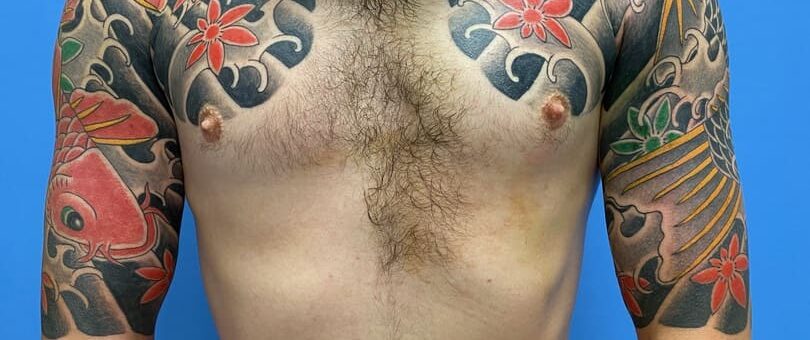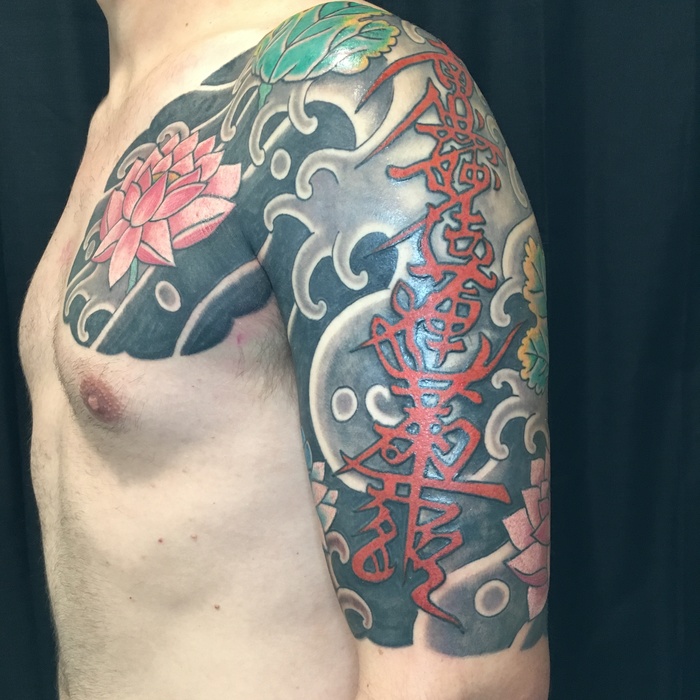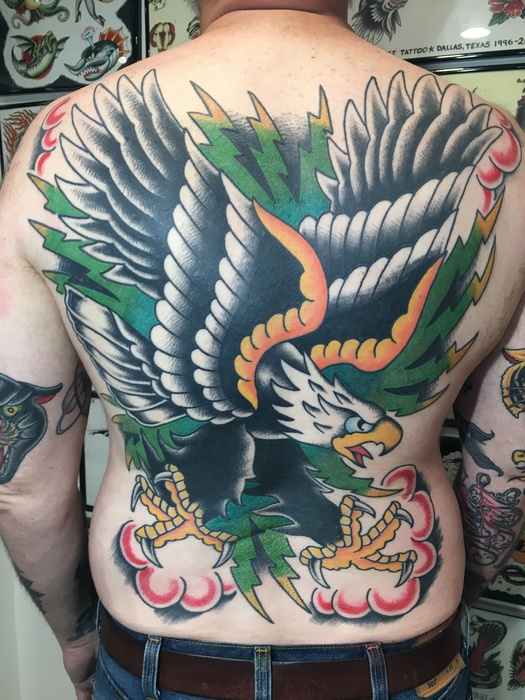
What is an Irezumi (Japanese) Tattoo?
- Posted by CHallowell
- On December 1, 2021
Irezumi is a traditional style of Japanese tattoo art that has a rich history and cultural significance. The term “irezumi” translates to “inserting ink” and it refers to the traditional Japanese tattooing style that has been practiced for centuries. The Japanese have many names such as Horimono and Wabori.
When Did Irezumi Start?
The practice of tattooing spans back through much of human history. Mummies have been discovered, marked with tattoos that are indelible to this day. The Polynesian cultures also developed their own language of heavily patterned tattoos. But it wasn’t until the 19th century that the Japanese invented the pictorial tattoo; And how grandly did they envision it!
Irezumi was the specific term for punitive tattooing forced upon criminals who were convicted of a crime. If the criminal had more crimes than they were indicated by more marks. Irezumi was merely a rough mark applied to brand the criminal. It was not artistic in any way.
Unfurling another concept of personal liberty, self governance, and self reliance, the Japanese tattooists, and tattoo collectors reclaimed this negative name for tattooing. They made it their own, re-defined it, and brought glory where once there was only the derogatory.
They called their breathtaking works of majestic full body tattooing irezumi. They took the good with the bad and embodied each of them in the soul of irezumi. The name stuck and is now known by the world over to represent the bodysuit tattooing of the Japanese style.
Designs undulated across history’s tattooed human bodies in the forms of animals, warriors, and flowers. Not to be outdone by this selection of main images, a background was invented to provide a setting in which these motifs could be placed.
The setting stylized the elements of the earth themselves, and the wind was portrayed in this wonderful art, blowing diagonally and powerfully; breezes swirled and eddied, clouds rolled and tumbled, and the water crashed and flowed.
It was born: a complete universe of patterns, for use exclusively in adorning the most precious canvas of all, the human form. This became known as traditional Japanese tattoos.
How is Irezumi Accomplished?
The art of tattooing in itself is beautiful and mysterious. In the early days of Japanese tattooing, the entire design was applied by the hands of the tattooist (horishi). Earlier tattoo arts around the world had been administered similarly. However, each was performed in its own way.
The Japanese example, for instance, uses the force of the dominant hand to push the needles into the skin, and remove them, leaving behind a permanent mark caused by push, puncture, and pain.
The left hand stretches the skin taut like a drum, and a little rhythm is tapped out that is unique to this form of tattooing, also known in Japan as “tebori tattoo.”
The horishi were open to experimenting with the American tattoo machine once Japan’s borders were open to outside influence and the tattoo machine had since been invented.
Slowly, a conversation opened between the tattooists of the west and the horishi of Japan. These were fringe artists on both sides with a sense of brotherhood there right off the bat. They were the shunned artists, pushed to the edges of town, hidden away. However, there were men and women who could not be controlled.
American freedom had by this time been firmly established, and the self seized freedom of the Japanese to practice their art of tattooing was an icebreaker shared between the continents that allowed each to open up a few of their secrets to each other.
Little by little, the art of tattooing itself has always been shrouded in secrecy and shared with a select and chosen few.
Some of the horishi found they could express their work in an elevated way by outlining with the American machine. When they tried to shade and color it, I think that they laughed.
Tebori had such power, control, and character. Many decided, “I will outline by modern machine, as it brings added possibilities to my work; I will shade and color by hand, as is tradition, as it is superior to shading and color done by machine.”
And thus, traditional Japanese tattooing was improved upon, whilst remaining steadfast and rooted in tradition.
Quality, Durability, and Pain
Because irezumi adorns a larger part of the body than its western counterpart, it is hands down the more extreme form of tattooing in every way.
There is more time invested in the work itself. This means more pain and more money. It also highly indicates more devotion to the end goal, which is very difficult to achieve.
In irezumi, as the complete body p[arts are tattooed, this means that marginal areas of the flesh are also considered, and covered over with tattooing. Many of these body parts are transitional spaces, for instance, between the armpit and pectoral area, these spaces are never addressed in more casual western tattooing, and they are extremely tender to endure getting tattooed.
Although irezumi could be said to be the highlight of any tattooing ever accomplished, the American traditional tattoo is highly realized and accomplished in its own right.
The serious American tattoo can cover much of the body as well, and, to accomplish this, it borrows from the concept introduced by irezumi that all separate images will be joined together by a background setting that stretches it from limb to limb. But make no mistake, these western tattoos are under the complete authorship of the traditional Japanese tattoo.
One old wives tale is firmly rooted in the international tattoo community. It states that an American tattoo is at its best when it is first put on. However, irezumi gets better with age. This is almost a zen koan in the world of professional tattoo artistry.
The reasons for this are many, but one must walk each road with authority before subtleties such as these are revealed. Remember that all tattooing is a closed circle of information. It is shared from acolyte to acolyte, from artist to collector, from horishi to the wearer of irezumi; all behind the closed doors of the tattoo studio.
How Much Irezumi Cost?
As already implied, irezumi is an investment in oneself that does not come cheaply. This complete approach to tattooing the body requires much time, effort, and diligence of the hands of the horishi.
There is nothing mass produced, imported, no corners cut, no throwaway verse, no rushing any part of the process, lest it endanger the whole.
The client pays for the work hour by hour, session by session. Horishi and clients usually work together in evenly spaced sessions of a regular number of hours. Each horishi has his own predilections here. Each client has their own appetite, budget, and physical limitations. The mental capacity for these endeavors is also highly determinative of the course taken to ultimately achieve irezumi.
The work is never paid for all at once, upfront, so this makes it akin to the purchase of any larger investment, or the upkeep of a hobby in which recurring costs are managed and offset by the joy or fulfillment one receives with its practice.
Each horishi will have its own hourly rate. These usually reflect their experience, output, position, and reputation among the clientele they serve. There are different tiers of pricing that closely align with the quality that they offer.
The pricing tiers can differ greatly, as you can select between novice and master level artists, and everything in between. However, each of these tiers has a fairly regulated range of pricing. Most experienced master horishi charge similar prices to one another. Some prefer to keep the price on the lower end, to reflect the populist roots of tattooing, whereas some would rather set the price to the higher end of the standard, to demand excellence in every area of the work, and to set forth that expectation from the get go.
As with anything, the larger the work you choose, the more hours it will take, and the more expensive it will ultimately be. A mix of common sense and critical thinking with some real world experience in tattooing will yield some guideposts to estimating cost. Half sleeves will take a considerable time to achieve, with many sessions needed.
Longer sleeve lengths will obviously extend this time. The full Japanese back piece can be achieved in about the same length of time that it takes to put on a pair of sleeves. The full bodysuit has several different variations, and, the more full the coverage, once again, the greater the time needed and cost accrued will be.
Where To Get Irezumi Tattoos?
The facilitation of the dream of irezumi is what we should seek from the horishi. They will take the landscape of seemingly unending imagery and distill it into a single vision. They will provide all relationships, meanings, symbolisms. They will guide in the images, the pairings of images, the overall vocabulary of the work. Finally, they will artfully create, design, and apply these ideals and images to the skin.
Without this guidance, we cannot achieve authentic irezumi on our own. Seek him out, and succeed.
This essay on irezumi was written by Carl Hallowell, a highly experienced horishi who tattoos under the honorific title “Horisho”. If you are looking for a Japanese inspired tattoo artist, please use the contact form to message Carl today to begin your journey into irezumi.



